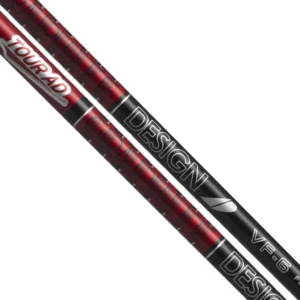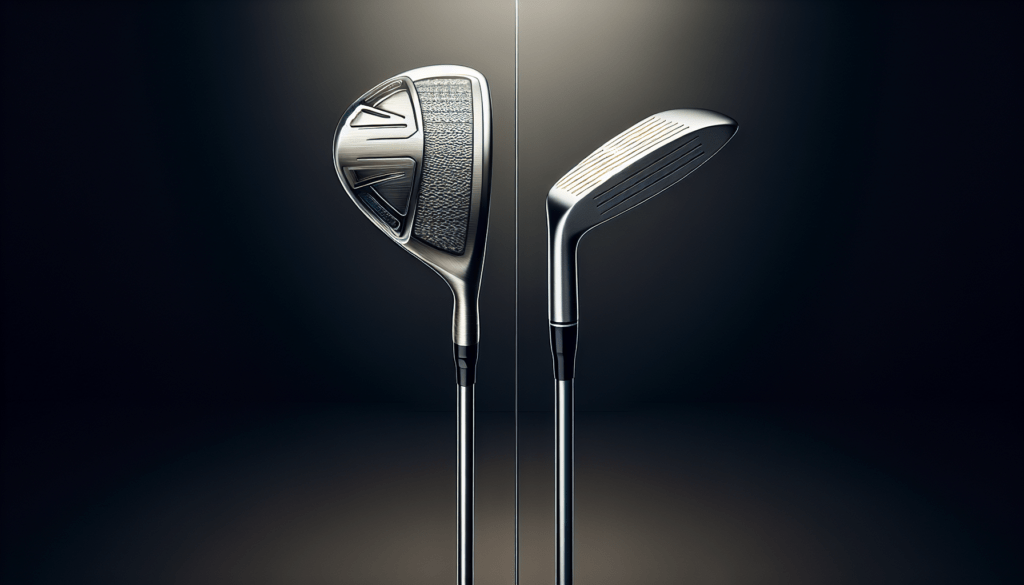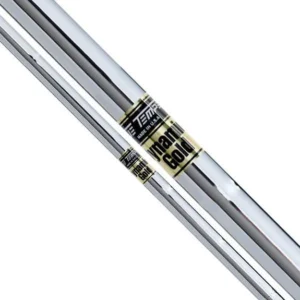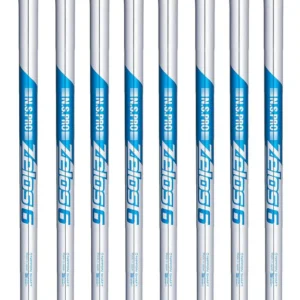Are you an avid golfer looking to upgrade your clubs? If so, you may be wondering what the difference is between steel and graphite shafts. Look no further, as we have the answer for you! ClubhouseLegends is here to provide you with all the information you need to make an informed decision. From explaining the properties of each material to discussing the advantages and disadvantages, we’ve got you covered. So, before you head to the golf store, read on to discover the key distinctions between steel and graphite shafts. Your game will thank you!
Weight
Steel Shafts
Steel shafts are generally heavier than graphite shafts. The heavier weight of steel shafts can provide a couple of advantages for certain golfers. Firstly, the added weight can help you generate more power through your swing, resulting in increased distance and better control. Secondly, the heavier shafts can provide more stability and consistency in your shots, especially if you have a fast swing speed. However, the extra weight may not be suitable for everyone, as it can negatively impact players with slower swing speeds or those seeking more flexibility and comfort in their swing.
Graphite Shafts
Graphite shafts, on the other hand, are significantly lighter than steel shafts. This lighter weight can be beneficial for golfers who have slower swing speeds or those who want to reduce the strain on their joints and muscles. The lighter weight allows for increased swing speed, which can result in greater distance for players who may not have the power generated by a steel shaft. Additionally, the lighter and more flexible nature of graphite shafts allows for better shock absorption, leading to fewer vibrations and a smoother feel throughout the swing. Graphite shafts are generally favored by beginners, seniors, and those with less physical strength.
Flexibility
Steel Shafts
Steel shafts are known for being stiffer and offering less flexibility compared to graphite shafts. This stiffness can provide more control and accuracy for players who already have a fast and aggressive swing. The reduced flexibility helps in minimizing face rotation during impact, resulting in straighter shots. However, the lack of flexibility may not be suitable for players who lack strength or have a slower swing speed, as it can make it more difficult to generate power and distance.
Graphite Shafts
Graphite shafts are typically more flexible than steel shafts, allowing for a greater degree of bending and twisting during the swing. The increased flexibility of graphite shafts can benefit players with slower swing speeds or those who want to achieve maximum distance without exerting excessive force. The extra flex in graphite shafts helps to create a whip-like action, translating into more clubhead speed and ultimately more distance. Additionally, the flexibility can also help to absorb shock and vibrations, leading to a more comfortable and forgiving feel throughout the swing.

Vibration Dampening
Steel Shafts
Steel shafts generally transmit more vibrations and feedback from the clubhead to the golfer’s hands compared to graphite shafts. While some players appreciate the enhanced feedback as it can provide a better sense of control and feel, it can also be detrimental for those who have joint issues or prefer a smoother, more comfortable swing. The increased vibration can lead to discomfort and potentially affect accuracy and consistency for some players.
Graphite Shafts
Graphite shafts are renowned for their superior vibration dampening capabilities. The composite material used in graphite shafts helps to absorb and reduce vibrations transmitted from the clubhead, resulting in a smoother and more comfortable swing. The reduced vibrations can be particularly beneficial for players with joint problems or those looking for a more forgiving and enjoyable golfing experience. Additionally, the decreased vibration can also minimize the risk of developing repetitive strain injuries.
Power
Steel Shafts
Steel shafts are often associated with providing more power due to their heavier weight and increased stability. The added weight of steel shafts allows for a more aggressive swing, allowing stronger players to generate greater clubhead speed and transfer more power to the ball. The additional power generated by steel shafts can result in longer distances and better control for those with the necessary physical strength and swing speed. However, it’s worth noting that power is subjective, and golfers with slower swing speeds or specific swing characteristics may find graphite shafts more suitable for generating power.
Graphite Shafts
Graphite shafts may not naturally offer as much power as steel shafts due to their lighter weight. However, the flexibility and lighter construction of graphite shafts can generate a different type of power. The increased flexibility allows for a smoother and more efficient energy transfer from the golfer to the clubhead, resulting in increased clubhead speed and distance. Golfers with slower swing speeds can benefit significantly from graphite shafts, as the added whip-like action and increased swing speed can make up for any potential loss in power from the lighter weight.

Distance
Steel Shafts
Steel shafts have traditionally been associated with delivering less distance compared to graphite shafts. The heavier weight and stiffer nature of steel shafts may not allow for the same level of clubhead speed and whip-like action as graphite shafts. However, it’s essential to consider that distance is influenced by various factors, including swing speed, swing mechanics, and individual player characteristics. While steel shafts may not naturally provide maximum distance for all players, they can still be suitable for those with fast swing speeds and the ability to generate power efficiently.
Graphite Shafts
Graphite shafts are often considered optimal for maximizing distance, especially for players with slower swing speeds. The lighter weight and increased flexibility allow for greater clubhead speed and a more efficient transfer of energy. The whip-like action generated by graphite shafts can provide additional distance as the shaft loads and releases energy during the swing. Golfers who struggle with generating distance or who prioritize maximum length off the tee can benefit from the extra boost in distance that graphite shafts offer.
Launch Angle
Steel Shafts
Steel shafts tend to produce a lower launch angle compared to graphite shafts. The stiffer nature of steel shafts restricts the amount of shaft deflection, resulting in a lower trajectory. This lower launch angle can be advantageous in certain playing conditions, such as strong winds or when trying to keep the ball flight lower for better control. However, golfers who struggle with getting the ball airborne or who prefer a higher launch to maximize carry distance may find steel shafts less suitable for their needs.
Graphite Shafts
Graphite shafts generally promote a higher launch angle due to their increased flexibility. The increased deflection in the shaft during the swing helps to elevate the ball higher into the air, allowing for optimal carry distance and potential stopping power on the greens. The higher launch angle can be particularly beneficial for players with slower swing speeds, as it helps to add height and distance to their shots. Golfers looking to maximize their carry distance and optimize their approach shots may find graphite shafts more suitable for achieving a higher launch.

Accuracy
Steel Shafts
Steel shafts are often praised for providing more control and accuracy in golf shots. The stiffer nature of steel shafts reduces the amount of shaft deflection during the swing, resulting in less face rotation and a more consistent clubface position at impact. This reduced face rotation can help to produce straighter shots and tighter dispersion patterns. Golfers who prioritize accuracy and consistency over maximum distance may prefer the predictability that steel shafts offer.
Graphite Shafts
Graphite shafts can provide excellent accuracy, but they may not offer the same level of precision as steel shafts for all players. The increased flexibility in graphite shafts can lead to slight variations in the clubface position at impact, potentially resulting in slightly less predictable ball flights. However, it’s crucial to note that the impact on accuracy can vary depending on the individual player’s swing characteristics and preferences. Some golfers may find that the added distance and forgiveness provided by graphite shafts outweigh any minor compromise in shot dispersion.
Durability
Steel Shafts
Steel shafts are known for their exceptional durability and ability to withstand the rigors of regular golf play. The sturdy construction and resilience of steel make them less prone to damage from mishits and impacts. Steel shafts can withstand the stress of aggressive swings and are less likely to break or develop issues over time. This durability makes steel shafts an excellent choice for golfers who prioritize long-term reliability and minimal maintenance.
Graphite Shafts
Graphite shafts, while generally durable, are more susceptible to damage compared to steel shafts. The lighter and more flexible construction of graphite makes them more prone to breakage and wear over extended use. Graphite shafts can be vulnerable to cracks, delamination, and damage from mishits or excessive force. However, modern advancements in graphite shaft technology have significantly improved durability, and high-quality graphite shafts can withstand the demands of regular play. It’s essential to handle graphite shafts with care and inspect them regularly for any signs of damage to ensure their longevity.

Cost
Steel Shafts
Steel shafts are generally more affordable compared to graphite shafts. The manufacturing process and materials used for steel shafts contribute to their lower cost. The affordability of steel shafts makes them an attractive option for golfers who are on a budget or who prefer a more economical alternative. Additionally, steel shafts tend to have a longer lifespan, reducing the need for frequent replacements and further adding to their cost-effectiveness.
Graphite Shafts
Graphite shafts are typically more expensive than steel shafts. The higher cost can be attributed to the advanced materials and manufacturing processes involved in creating graphite shafts. The increased flexibility, lighter weight, and enhanced performance characteristics of graphite shafts make them a popular choice among golfers, but this premium comes with a higher price tag. Despite the initial investment, golfers who value the benefits provided by graphite shafts may consider the higher cost justified.
Skill Level
Steel Golf Club Shafts
Steel shafts have long been favored by more experienced and skilled golfers. The heavier weight and stiffer nature of steel shafts provide the stability and control that advanced players often seek to refine their swing mechanics and achieve consistent ball striking. The precision and feedback offered by steel shafts can help skilled golfers dial in their shots and enhance their overall performance. However, this doesn’t mean that steel shafts are exclusively suitable for skilled players, as golfers of all skill levels can benefit from their characteristics depending on their individual swing dynamics and preferences.
Graphite Golf Club Shafts
Graphite shafts are widely regarded as more forgiving and suited for players of varying skill levels, including beginners and those with limited physical strength. The lighter weight and increased flexibility of graphite shafts make it easier to generate clubhead speed and achieve optimal distance, even for golfers with slower swing speeds. The enhanced forgiveness and shock absorption provided by graphite shafts can help beginners and less experienced players improve their confidence and overall game. Skilled golfers can also benefit from graphite shafts, especially those looking to maximize distance and playability while maintaining a good degree of control.
In conclusion, the choice between steel and graphite shafts ultimately depends on individual preference, playing characteristics, and goals. Steel shafts are typically heavier, stiffer, and provide more control, while graphite shafts offer lighter weight, increased flexibility, and enhanced distance potential. Consider factors such as swing speed, skill level, desired distance, accuracy, and personal feel to determine which type of shaft is most suitable for your game. Consulting with a professional club fitter or golf instructor can also provide valuable insight and help you make an informed decision. Remember, the right shaft can significantly impact your performance and overall enjoyment on the golf course. Happy golfing!
